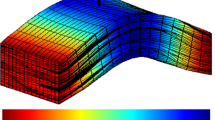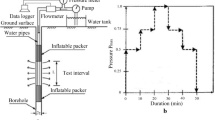Abstract
Field permeability tests are used to evaluate the local hydraulic conductivity. Their interpretation requires knowing the value of a shape factor, c. Regular values for shape factors were obtained for fully saturated conditions in an infinite material. However, many tests are performed in unconfined aquifers, with a bottom impervious boundary, and partly unsaturated seepage. This paper questions the applicability of the regular c values to field conditions. It presents numerical ways to model field permeability tests in unconfined aquifers and deduce the c value, under steady and transient states, with partly unsaturated seepage. Two series of monitoring wells were analyzed and compared; they have either a filter pack or not. The influences of four variables (radial distance of the external boundary, dimensions and positions of the water injection zone, and aquifer material type) on the numerical c values were studied. The results show that the boundary radial distance markedly affects the numerical c value. Therefore, practical approaches were proposed by reconciling the numerical and realistic test conditions, to determine the representative boundary radial distances for each type of test model. Additionally, the numerical values are compared with the theoretical values of Bouwer and Rice (Water Resour Res 12(3):423–428, 1976) and Hvorslev (Time-lag and soil permeability in ground water observations, U.S. Army Eng Waterw Exp Stn, Vicksburg, 1951).



















Similar content being viewed by others
References
Al-Dhahir ZA, Morgenstern NR (1969) Intake factors for cylindrical piezometer tips. Soil Sci 107(1):7–21
Ardejani FD, Badii K, Limaee NY, Mahmoodi NM, Arami M, Shafaei SZ, Mirhabibi AR (2007) Numerical modelling and laboratory studies on the removal of Direct Red 23 and Direct Red 80 dyes from textile effluents using orange peel, a low-cost adsorbent. Dyes Pigments 73(2):178–185
Aubertin M, Mbonimpa M, Bussière B, Chapuis RP (2003) A model to predict the water retention curve from basic geotechnical properties. Can Geotech J 40(6):1104–1122
Baptiste N, Chapuis RP (2015) What maximum permeability can be measured with a monitoring well? Eng Geology 184:111–118
Bouwer H (1989) Bouwer and Rice slug test—an update. Groundwater 27(3):304–309
Bouwer H, Rice RC (1976) A slug test for determining hydraulic conductivity of unconfined aquifers with completely or partially penetrating wells. Water Resour Res 12(3):423–428
Brand EW, Premchitt J (1980) Shape factors of cylindrical piezometers. Géotechnique 30(4):369–384
Brand EW, Premchitt J (1980) Shape factors of some noncylindrical piezometers. Géotechnique 30(4):536–537
Brand EW, Premchitt J (1982) Response characteristics of cylindrical piezometers. Géotechnique 32(3):203–216
Çelik B, Rowe RK, Ünlü K (2009) Effect of vadose zone on the steady-state leakage rates from landfill barrier systems. Waste Manag 29(1):103–109
Chapuis RP (1989) Shape factors for permeability tests in boreholes and piezometers. Ground Water 27(5):647–654
Chapuis RP (1998) Overdamped slug test in monitoring wells: review of interpretation methods with mathematical, physical, and numerical analysis of storativity influence. Can Geotech J 35(5):697–719
Chapuis RP (2004) Predicting the saturated hydraulic conductivity of sand and gravel using effective diameter and void ratio. Can Geotech J 41(5):787–795
Chapuis RP (2005) Numerical modeling of rising-head permeability tests in monitoring wells after lowering the water level down to the screen. Can Geotech J 42(3):705–715
Chapuis RP (2009) Numerical modeling of reservoirs or pipes in groundwater seepage. Comput Geotech 36(5):895–901
Chapuis RP (2009) Variable head permeability tests in monitoring wells: comparing the shape factor defined by Bouwer and Rice (1976) to the shape factor given by Hvorslev (1951). Geotech News 27(1):41–43
Chapuis RP (2012) Influence of element size in numerical studies of seepage: small-scale details. Geotech. News 30(1):32–35
Chapuis RP (2012) Influence of element size in numerical studies of seepage: unsaturated zones, transient conditions. Geotech. News 30(4):16–19
Chapuis RP (2016) Proof of multiplicity of solutions for groundwater seepage in recharged heterogeneous unconfined aquifers. Int J Numer Anal Methods Geomech 40(14):1988–2002
Chapuis RP (2017) Stress and strain fields for overdamped slug tests in aquifer materials, and resulting conservation equation. Int J Numer Anal Met 41(18):1908–1921
Chapuis RP (2017) A simple reason explains why it is so difficult to assess groundwater ages and contamination ages. Sci Total Environ 593:109–115
Chapuis RP, Aubertin M (2001) A simplified method to estimate saturated and unsaturated seepage through dikes under steady-state conditions. Can Geotech J 38(6):1321–1328
Chapuis RP, Bélanger C, Chenaf D (2006) Pumping test in a confined aquifer under tidal influence. Ground Water 44(2):300–305
Chapuis RP, Chenaf D (2002) Slug tests in a confined aquifer: experimental results in a large soil tank and numerical modeling. Can Geotech J 39(1):14–21
Chapuis RP, Chenaf D (2003) Effects of monitoring and pumping well pipe capacities during pumping tests in confined aquifers. Can Geotech J 40(6):1093–1103
Chapuis RP, Chenaf D, Acevedo N, Marcotte D, Chouteau M (2005) Unusual drawdown curves for a pumping test in an unconfined aquifer at Lachenaie, Quebec: field data and numerical modeling. Can Geotech J 42(4):1133–1144
Chapuis RP, Chenaf D, Bussière B, Aubertin M, Crespo R (2001) A user’s approach to assess numerical codes for saturated and unsaturated seepage conditions. Can Geotech J 38(5):1113–1126
Chapuis RP, Dallaire V, Gagnon F, Marcotte D, Chouteau M (2007) Falling-head permeability tests in an unconfined sand aquifer. Geotech Test J 30(2):104–112
Chapuis RP, Masse I, Madinier B, Duhaime F (2015) Water-retention curves of coarse soils without organic matter: improved data for improved predictions. Geotech Test J 38(3):325–337
Chapuis RP, Paré JJ, Lavallée JG (1981) In situ variable head permeability tests. In: Proceedings of 10th international conference on soil mechanics and foundation engineering, pp 401–406
Chesnaux R, Chapuis RP, Molson JW (2006) A new method to characterize hydraulic short-circuits in defective borehole seals. Groundwater 44(5):676–681
Chiasson P (2005) Methods of interpretation of borehole falling-head tests performed in compacted clay liners. Can Geotech J 42(1):79–90
Chu-Agor ML, Wilson GV, Fox GA (2008) Numerical modeling of bank instability by seepage erosion undercutting of layered streambanks. J Hydrol Eng 13(12):1133–1145
Dachler R (1936) Grundwasserstromung. Julius Springer, Vienna
Geo-Slope Int Ltd (2012) SEEP/W for finite element seepage analysis: user’s guide. Geo-Slope Int Ltd, Calgary
Haverkamp R, Zammit C, Bouraoui F (1997) Grizzly soil data bank, base de données de paramètres caractéristiques des sols. LTHE, Grenoble
Hvorslev MJ (1951) Time-lag and soil permeability in ground water observations. U.S. Army Eng Waterw Exp Stn, Vicksburg
Jin SW, Choo YW, Kim YM, Kim DS (2014) Seepage characteristics of a buttressed embankment with a low permeable foundation: centrifuge and numerical studies. Trans ASABE 57(2):463–477
Kallstennius T, Wallgren A (1956) Pore water pressure measurement in field investigations. In: Proceedings of the Royal Swedish Geotechnical Institute No. 13
Klammler H, Nemer B, Hatfield K (2014) Effect of injection screen slot geometry on hydraulic conductivity tests. J Hydrol 511:190–198
Kosugi KI (1994) Three-parameter lognormal distribution model for soil water retention. Water Resour Res 30(4):891–901
Kovács G (1981) Seepage hydraulics. Elsevier, Amsterdam
Lafhaj Z, Shahrour I (2002) Use of the electric analogy for the determination of the shape factor in complex soil conditions. Int J Phys Model Geotech 2(4):39–44
Lefranc E (1926) Procédé de mesure de la perméabilité des sols dans les nappes aquifères et application au calcul du débit des puits. Le Génie Civil 109(15):306–308
Lefranc E (1937) La théorie des poches absorbantes et son application à la détermination du coefficient de perméabilité en place et au calcul du débit des nappes d’eau. Le Génie Civil 111(20):409–413
Leij FJ, Alves WJ, van Genuchten MTh, Williams JR (1996) The UNSODA unsaturated soil hydraulic database. Version 1.0. US Environmental Protection Agency, National Risk Management Research Laboratory, Cincinnati. Report No.: EPA/600/R-96/095
Lowther G (1978) A note on Hvorslev’s intake factors. Géotechnique 28(4):465–466
Mathias SA, Butler AP (2007) Shape factors for constant-head double-packer permeameters. Water Resour Res 43(6):1–7
Mbonimpa M, Aubertin M, Bussière B (2006) Predicting the unsaturated hydraulic conductivity of granular soils from basic geotechnical properties using the modified Kovacs (MK) model and statistical models. Can Geotech J 43(8):773–787
Mualem Y (1976) A catalogue of the hydraulic properties of unsaturated soils. Development of methods, tools and solutions for unsaturated flow with application to watershed hydrology and other fields. Technion Israel Institute of Technology, Haifa. Research Project 442
Randolph MF, Booker JR (1982) Analysis of seepage into a cylindrical permeameter. In: Proceedings of 4th international conference on numerical methods in geomechanics, pp 349–357
Ratnam S, Soga K, Whittle RW (2001) Revisiting Hvorslev’s intake factors using the finite element method. Géotechnique 51(7):641–645
Raymond GP, Azzouz MM (1969) Permeability determination for predicting rates of consolidation. In: British Geotechnical Society conference on in-situ investigations in soils and rocks, pp 285–293
Selvadurai AP (2004) Fluid intake cavities in stratified porous media. J Porous Media 7(3):1–17
Silvestri V, Bravo-Jonard C, Abou-Samra G (2011) A note on Hvorslev’s shape factor for a flush bottom piezometer in uniform soil. Geomech Eng 3(2):109–116
Silvestri V, Abou-Samra G, Bravo-Jonard C (2012) Shape factors of cylindrical piezometers in uniform soil. Groundwater 50(2):279–284
Silvestri V, Bravo-Jonard C, Abou-Samra G (2013) A note on the validity of Hvorslev’s shape factors for well points and piezometers. Geotech Test J 36(1):138–145
Smiles DE, Youngs EG (1965) Hydraulic conductivity determinations by several field methods in a sand tank. Soil Sci 99(2):83–87
Tavenas F, Diene M, Leroueil S (1990) Analysis of the in situ constant-head permeability test in clays. Can Geotech J 27(3):305–314
Van Genuchten MT (1980) A closed-form equation for predicting the hydraulic conductivity of unsaturated soils. Soil Sci Soc Am J 44(5):892–898
Wilkinson WB (1968) Constant head in situ permeability tests in clay strata. Géotechnique 18(2):172–194
Zhang L, Chapuis RP, Marefat V (2019) Field permeability tests with inward and outward flow in confined aquifer. Geotech Test J. https://doi.org/10.1520/GTJ20170417
Zhang L, Chapuis RP (2019) Recovery test after a constant-head test in a monitoring well: interpretation methods and new findings. Eng Geol. https://doi.org/10.1016/j.enggeo.2019.105150
Acknowledgements
The first author is grateful to the China Scholarship Council for its financial support. All authors would like to show their gratitude to the Natural Sciences and Engineering Research Council of Canada (NSERC) for sponsoring their research on field permeability tests and numerical studies.
Author information
Authors and Affiliations
Corresponding author
Additional information
Publisher's Note
Springer Nature remains neutral with regard to jurisdictional claims in published maps and institutional affiliations.
Rights and permissions
About this article
Cite this article
Zhang, L., Chapuis, R.P. & Marefat, V. Numerical values of shape factors for field permeability tests in unconfined aquifers. Acta Geotech. 15, 1243–1257 (2020). https://doi.org/10.1007/s11440-019-00836-4
Received:
Accepted:
Published:
Issue Date:
DOI: https://doi.org/10.1007/s11440-019-00836-4




